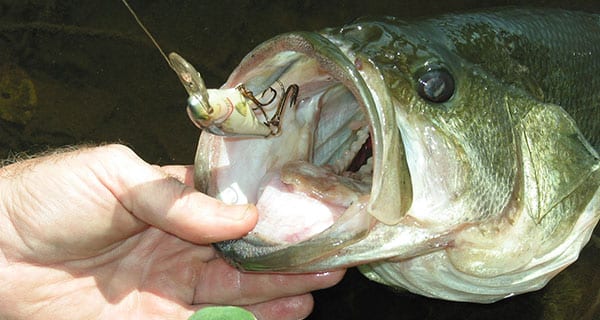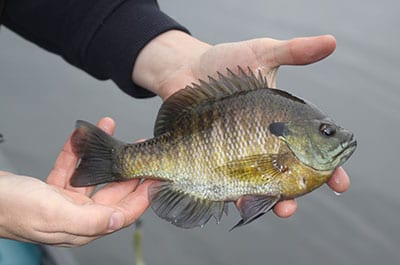
By Tom Schlichter
Talking freshwater fishing to a few local youngsters a while back, I was surprised at a single question that arose several times as we discussed where to cast for sunfish, bass and pickerel.
“How do you know where in a lake different kinds of fish live?”
To be sure, once you’ve been fishing for a few years, the answer to this question is really second nature. Bass like structure; sunnies prefer weedy flats; pickerel patrol edges; trout like open water or cool streams. Advanced anglers know where to look. But the question is still valid, and not only for beginners. I think many of us use a sense gained through experience to pick out where to cast on any given day. Maybe a few of us even use “The Force.” Either way, anyone from expert to novice would do well to occasionally try and figure out not only where the fish are, but why they prefer particular habitats.
“Can you look at a fish and tell where it lives?” continued one persistent youngster in my group. “If you go to a lake and you’ve never seen a certain kind of fish before, can you look at a picture and know where to cast? Can you tell what it eats?”
A CLOSE INSPECTION

The answer, generally speaking, is yes. There are actually several tip-offs we can glean simply from looking at a fish’s physical characteristics.
Consider sunfish, for example. Their vertically compressed bodies suggest they might do well cutting through thin channels and pockets in weedy waters. Relatively small, they might favor shallow areas where larger predators feel too exposed to lurk. With tiny, toothless mouths, it’s a good bet they eat bugs, emerging terrestrials and worms. With rounded bodies, they can corner well, hover in place or maneuver in tight quarters that larger or less agile fish might avoid.
Chain pickerel, by contrast, have a ferocious set of teeth. Sporting a green background and white or yellow chain-like markings, they blend well with weedy patches but seem too long and slender to tuck back into thick weed mats and sticky moss. Perhaps that’s why anglers often find them patrolling the edges and points of prominent weed beds and lily patches.
Their long, lean bodies also suggest this species might like shallow water, perhaps near a log where their shape could easily be mistaken by unwary baitfish as another submerged branch. In early spring and during the fall months, that thin, tubular build also allows pickerel to slide within inches of shore to soak up the warmth of the shallows and, perhaps, grab a sunfish or small minnow without expending much energy.
It is, of course, other fish on which a pickerel feeds. Why else would it have such toothy jaws? With smallish fins, but a large, forked tail, pickerel are surely built for fast, short bursts. They are essentially ambush predators, trying to blend into shallow areas suitable for a stealthy but powerful attack against anything that swims nearby.

THERE’S A REASON FOR THAT MOUTH!
Largemouth bass are king of the food chain in most small to mid-sized lakes and ponds. They are built for versatility and strength; two traits that serve well in a world of eat or be eaten.
The obvious trait in a largemouth’s design is that huge maw. With it, bass can suck down fish that are too large to be eaten by other predators in most waters. They can also swallow alive frogs, new-born ducklings, dragon flies, eels, snakes, salamanders, lizards, baby muskrats or just about anything else that swims. The biggest bass have the largest mouths, so you might try using big lures and baits to catch their attention.
Largemouths also sport large bellies, suggesting they can grab one big bite for brunch and not feed for a while thereafter, or perhaps fill up on a bunch of smaller appetizers and then go sulk for a day or two. I once caught and released a 16-inch largemouth on a 10-inch golden shiner. As a teenager, when I occasionally took a bass home for dinner, I caught a 14-inch largemouth that contained four six-inch long crayfish, a giant June bug, plus a two-inch long sunny. That fish’s belly was distended and it still smacked a 5-inch Rebel plug. I bet it sulked for three or four days after I let it go.
While the mouth and belly of a bigmouth bass stand out, there are additional physical traits that help us understand this predator and the areas it favors. Again, greenish shades suggest a species that thrives in weedy areas. The strong, balanced body and broad tail indicate a fish that can swim in open water if needed but can go shallow or suspend at mid-depths. Its big eyes are a tip-off that it feeds well in low light conditions and, indeed, the biggest bass are often caught at dawn, dusk or after dark.
ADDITIONAL FISH TALES
The physical traits of many other freshwater fish tip their hand. The giant milky eyes, slender bodies and big fangs of a walleye suggest a night feeder that favors live baitfish in open water. The barbells, brown coloration and portly body of bullhead catfish indicate a scavenger that prefers muddy or murky bottom waters where it can feel and smell its dinner without sight or speed being a significant factor in success.
So, the next time you catch a fish – any fish – take a few seconds to examine it from top to bottom and front to back. You may already know where the action is on your local lake and pond but trying to figure out why a particular species favors a specific spot, lure or bait is always fun. It’s also great practice for the next time you end up fishing new waters or pursuing unfamiliar game. In that instance, like my crew of youngsters who prompted this conversation, it’s easy to feel like a beginner.









